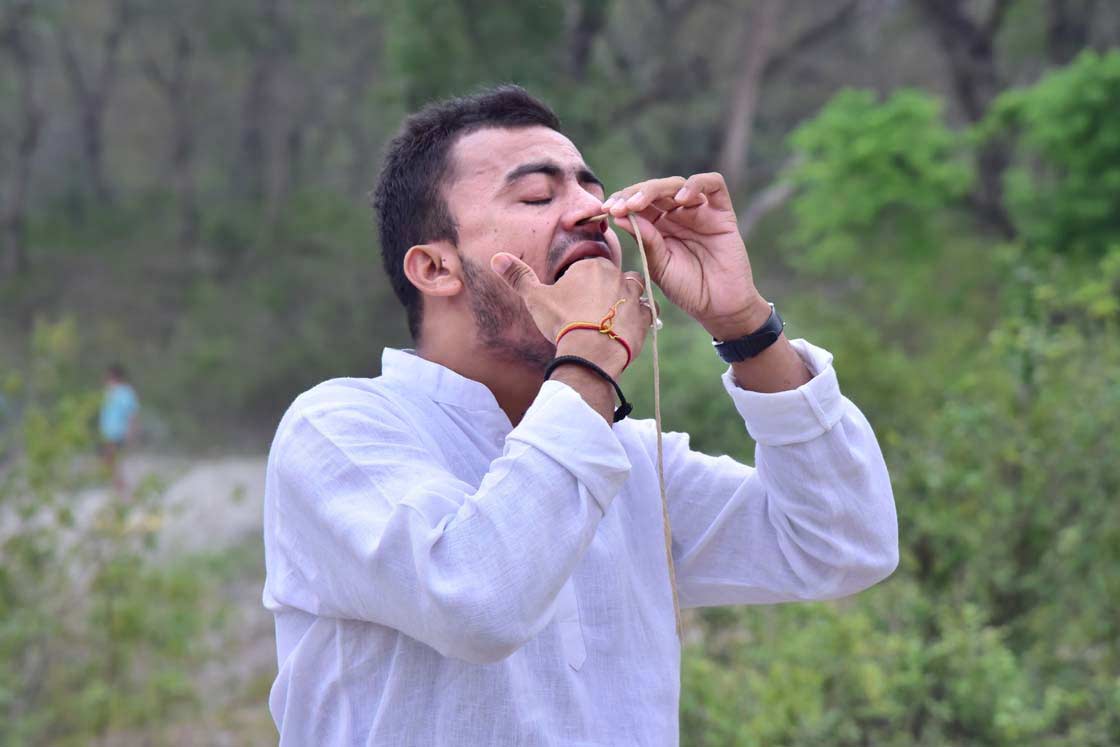- What is Sutra Neti
- Use of thread
- Anatomy of Nasal Cavity
- How to Do Sutra Neti
- Benefits
- Precautions
- FAQs

Sutra Neti is a yogic cleansing practice used to clear the nasal passages and improve respiratory health. It is one of the Shatkarma, or “six purification techniques,” and is an essential part of Hatha Yoga, aimed at maintaining and enhancing overall physical well-being. This practice involves using a thread or catheter to remove mucus and debris from the nasal passages, facilitating clearer and smoother breathing.
Incorporating Sutra Neti into your routine offers notable benefits, including improved breathing. The technique effectively clears blockages and excess mucus, leading to more open and efficient airflow through the nasal passages.
What does Sutra Neti mean?
Sutra Neti is a nasal cleansing technique where a thread or catheter is used to clear the nasal passages. The term “Sutra” translates to “thread” in Sanskrit, and “Neti” refers to “nasal cleaning.” This technique involves inserting a thread or rubber catheter through one nostril and guiding it out through the mouth. This process helps remove mucus and other debris, opening up the nasal passages for improved airflow and overall respiratory health.
Sutra Neti is detailed in ancient yogic texts such as the Hatha Yoga Pradipika and Gheranda Samhita, which describe its use for purifying the nasal passages and promoting general well-being. Whether using a cotton thread or a rubber catheter, the practice helps in clearing blockages and can be beneficial for individuals experiencing nasal congestion or other respiratory issues.
Also Read: What Is Neti Kriya and It’s Type
What thread should be used in Sutra Neti?
For Sutra Neti, you can use a cotton thread that is approximately 4mm wide and 36 cm long. This size is suitable for passing through the nose and out through the mouth. Cotton threads for this practice are readily available in stores or online.
It is essential to lubricate the cotton thread with beeswax or another suitable agent to prevent discomfort or nausea.
Alternatively, a thin rubber catheter, which is 1 to 3 mm thick and soft, can be used. This type of catheter is often preferred by beginners because it slides more easily through the nasal passages compared to a cotton thread.
Understanding nasal anatomy for Sutra Neti
Before starting Sutra Neti, beginners should understand the nasal cavity’s anatomy and how the thread moves through it.
The nasal cavity is like a long, narrow cave, with a tight roof and a wider floor. Near the base of the nose, there’s a valve leading to the upper back of the throat.
When performing Sutra Neti, keep the thread directed toward the back of the throat, moving it downward and inward. It should slide smoothly through the nasal passages and exit at the back of the throat.
The procedure should be pain-free. If you feel discomfort, check your technique to ensure the thread is inserted correctly and at the right angle.
How To do Sutra Neti (Steps)

- Take a thread dipped in beeswax or a rubber catheter. Rinse in warm water or specialized oils, then dry thoroughly.
- Insert the thread or catheter into one nostril, aiming towards the back of the throat.
- Reach into your mouth and grasp the thread at the back of the throat with your index and middle fingers.
- Pull the thread out through your mouth slowly and gently.
- Hold both ends of the thread and move it back and forth a few times.
- Repeat the process with the other nostril.
Note: Once you have mastered the procedure, you can perform Sutra Neti by passing the cord from one nostril to the other.
Time & Duration
- Duration: The best time to practice Sutra Neti is early in the morning, before breakfast, when the nasal passages are naturally open.
- Frequency: It is recommended to perform Sutra Neti once a week. Daily practice may weaken the natural receptors in the nasal passages.
Precautions
- Avoid Forcing the Thread: If the thread doesn’t pass easily, don’t push it forcefully to prevent nasal tissue damage and bleeding.
- Practice Before Pranayama: Perform Sutra Neti before asanas and pranayama to ensure open nostrils and effective breathing.
- Do Jal Neti First: Perform Jal Neti before Sutra Neti to moisturise nasal passages for smoother thread passage.
- Ensure Clean and Trimmed Thread: Clean the thread with warm saline water, let it dry, and trim the ends to prevent curling.
Contraindications
- Nasal Infections or Bleeding: Avoid Sutra Neti if you have an active nasal infection, bleeding, or severe congestion, as it can exacerbate these conditions.
- Recent Nasal Surgery: Do not practice Sutra Neti immediately after nasal surgery or trauma, as it can interfere with healing and cause discomfort.
- Severe Sinusitis or Allergies: If you have severe sinusitis or significant allergies, consult a healthcare provider before attempting Sutra Neti, as it may aggravate your symptoms.
- Pregnancy: Pregnant women should avoid Sutra Neti unless advised otherwise by a healthcare professional, due to potential risks or discomfort.
Benefits of Sutra Neti
These are some instant and long-term benefits of sutra neti you will feel when practicing it with proper instructions from an expert.
- Lightness in breathing: Practicing Sutra Neti after Jal Neti helps to clear excess mucus from the nasal passages. The thread used in Sutra Neti can open blocked mucus membranes, resulting in a lighter and more effortless breathing experience.
- Improves Vision: The delicate nerves connected to the eyes are linked with the nasal passages. When the thread passes through these areas, it stimulates these nerves, increasing blood flow. This enhanced circulation can lead to improved overall vision.
- ENT care: The eyes, nose, and ears (ENT) are interconnected, so a problem in one can affect the others. Regular practice of Sutra Neti is an effective way to address ENT issues. It helps with vocal cord problems, nasal congestion, and ear irritation. Using both Jal Neti and Sutra Neti can serve as natural remedies for these concerns.
- Alleviate Inflammation and Excessive Mucus: Sutra Neti helps clear mucus from blocked sinus cavities, reducing inflammation. It also addresses dried mucus that can cause nasal blockages. The process of Sutra Neti helps relieve these blockages and reduce inflammation by effectively removing excess mucus.
- Reduced Deviated Nasal Septum: A deviated nasal septum can cause various respiratory issues and may often require surgical intervention. Sutra Neti offers a natural remedy for this condition. While it is a long-term process, consistent practice can help reduce the obstruction caused by a deviated septum over time.
- The thread used in Sutra Neti stimulates the nerves and membranes in the nose, providing relief from symptoms such as cough, cold, and headache.
- Additionally, this practice activates dormant cells in the frontal brain, which can enhance hair growth, improve memory, and reduce insomnia.
Conclusion
Sutra Neti is a beneficial Hatha Yoga practice that clears nasal passages, improves breathing, and supports overall respiratory health. Regular use can reduce inflammation and aid in managing conditions like a deviated nasal septum. By integrating Sutra Neti into your routine, you can enhance your well-being and achieve better health.
FAQs Sutra Neti Kriya
It is generally recommended to practice Sutra Neti 1-2 times a week for best results.
Sutra Neti is safe for most people but should be avoided if you have nasal infections, severe sinus issues, or recent nasal surgery. Consult a healthcare provider if unsure.
It is not advisable to perform Sutra Neti during an acute cold or severe nasal congestion. Wait until symptoms improve.
Use a clean, soft, and non-irritating thread specifically designed for Sutra Neti, typically made of cotton or a similar material.
Clean the thread with warm saline water and let it dry completely before use to prevent infections.
Sutra Neti may help with mild sinus congestion by clearing nasal passages, but consult a healthcare provider for chronic sinusitis.
Practice Sutra Neti in the morning before other yoga practices or pranayama for optimal benefits.
Sutra Neti can cause minor side effects like nasal irritation, dryness, or discomfort if not done properly. Ensuring proper technique and hygiene can minimize these risks.





Thank you.
Please, could you let us know where best to buy both string neti and rubber neti too?
I was able to avoid hospitalization thanks to my use of a string neti a friend a yoga teacher showed me how to use it a decade prior; when I’d be profoundly affected by heavy pollen in the air in the east bay while I was in Concord, CA during the spring of 1994 when some sufferers were wearing complex filtering devices though with passage through both nostrils of a cloth neti from a Mount Madonna yoga store in Santa Cruz, CA. whose end was twisted in hot beeswax then allowed to cool I was lucky to have with me, my breathing was immediately back to normal.
There is a link mentioned in the article to buy Thread for rubber neti. You can buy it from there.
Thank you.